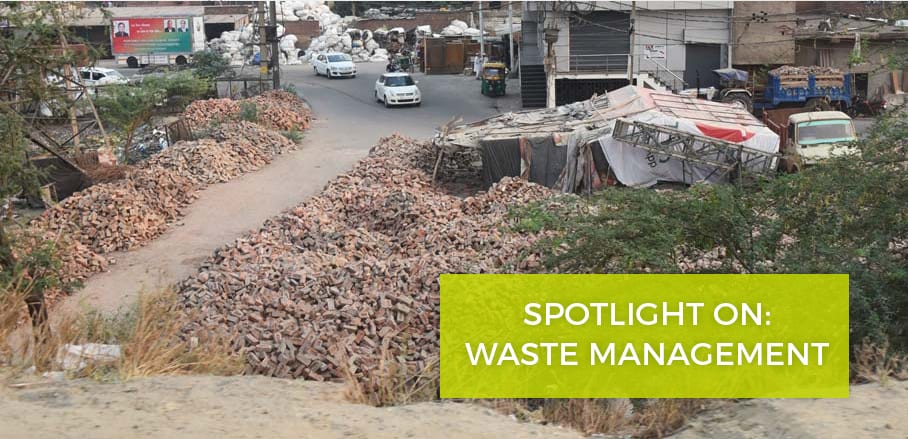Urban Mining – recovering materials in metropolitan regions
To what extent can cities be used as ‘anthropogenic material stocks’? How can international cooperation contribute? In the following interview, Professor Liselotte Schebek from Darmstadt’s Technical University and Uwe Becker, who manages a GIZ-run project in India, share their views on these issues.
The UN conference on urban development, Habitat III, took place in October last year. Cities should become more sustainable. What related challenges do you see regarding the use of resources?
Schebek: The evolution of material flows demonstrates the global trend towards urbanisation and the ongoing expansion of cities. Since 1900, mining of mineral resources for use in the construction sector as well as other raw materials has increased almost exponentially at the global level. Asia in particular is currently using enormous volumes of materials to sustain its building boom. This has led to a shortage of sand, which is a key component of concrete. For this reason Asia is a primary focus of future efforts to recycle building waste.
Becker: We can see this development in India, for example. Like China, India’s advancing urbanisation makes it a rapidly expanding market and a potential ‘hotspot’ for construction waste recycling. We don’t have official statistics, but according to current estimates, building waste accounts for around 25% of household waste. However, based on our own studies, we believe the volume is already significantly higher. And it’s set to increase even further in the next ten to twenty years. At present, around 60 to 80 % of all building waste is dumped illegally on the roadside, in parks or in the countryside. For builders this is the easy option – but for the environment and the resource-efficient use of secondary raw materials, it’s a major problem.
What do you understand by ‘urban mining’ and how does it need to be organised if it is to contribute to resource-efficient urbanisation?
Schebek: Urban mining is essentially about using so-called ‘anthropogenic material stocks’ to reclaim raw materials. Buildings and other infrastructure are prime examples of this kind of man-made material stock. The aim is to start recycling building waste so that it can be reused for building construction instead of putting it to inferior uses or depositing it on space-consuming dump sites. This calls for far-sighted strategic planning. As building materials are locked into buildings for very long periods of time, the planning challenges are very different to the ones we face when collecting and recycling household waste.
Becker: In India the informal sector is a key actor. In Delhi alone it is estimated that at least 10,000 people are employed on building sites. For example, groups of 20-30 people go to five-storey buildings and destroy the floors below them to get at the steel. They collect and sell virtually all the metals and plastics. Windows, doors and bricks are recycled.
In the end all that’s left over is essentially just the walls and concrete. Formal disposal options include using this waste to cover landfills or disposing of it at construction waste sites or in disused quarries. At present there are only three building waste recycling plants across the whole of India. One of the reasons there are so few of these plants is due to their current low economic viability. Waste producers charge money for their waste instead of paying for its disposal, and there is limited official enforcement against illegally dumped waste. The market for secondary materials is also an issue, as the construction sector still does not fully accept their use.
Schebek: In Germany too, there are still some acceptance issues in places. But really there is no reason for secondary materials to have such a bad reputation if they meet product quality standards. To increase levels of acceptance, it is particularly important that public-sector procurement agencies make a point of using secondary materials.
How is your work helping to move things along?
Becker: To increase the acceptance of recycling products, for example, we are assisting the cities of Delhi, Ahmedabad and Bangalore to develop certification schemes and to include recycled products in their public procurement contracts. The objective here is to build up a market for recycled products. As a starting point we have compiled market studies that determine the flow of materials in the building and demolition sectors.
We have provided support to the few recycling firms in operation as well as a number of companies and municipalities with increasing interest in the construction waste sector. In the automotive industry we are also examining options to move towards a circular economy and optimise resource consumption. At the national policy level, we have helped advance the establishment of an ‘Indian Resource Panel’. With our support, this panel is currently mapping out a plan of action, primarily to advise the Indian Government on resource efficiency and secondary raw materials usage in the building and automotive sectors.
Schebek: At the TU Darmstadt, we recently completed the research project ‘Techno-economic potential of reclaiming raw materials from industrial and commercial building stocks ( PRRIG )’. As part of this study, we compiled an inventory of the buildings and their embedded material stocks in the Rhine-Main metropolitan area. Using this as our basis, we then calculated which material flows we can expect over the next 10 to 20 years.
The interview was conducted by Pascal Renaud (GIZ, Sector Project ‘Concepts for Sustainable Waste Management’)
